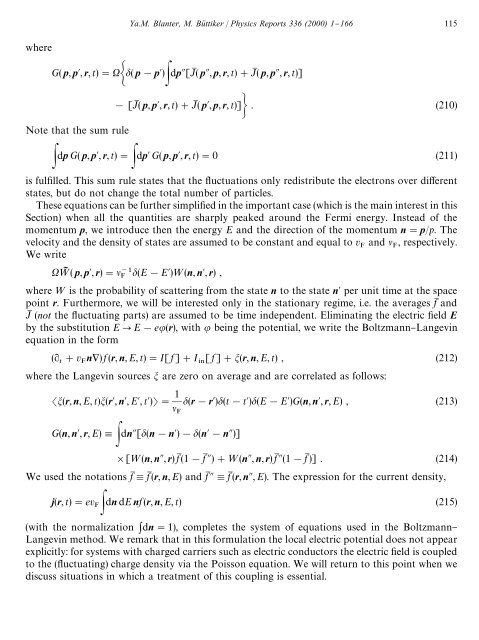shot noise in mesoscopic conductors - Low Temperature Laboratory
shot noise in mesoscopic conductors - Low Temperature Laboratory
shot noise in mesoscopic conductors - Low Temperature Laboratory
Create successful ePaper yourself
Turn your PDF publications into a flip-book with our unique Google optimized e-Paper software.
where<br />
Ya.M. Blanter, M. Bu( ttiker / Physics Reports 336 (2000) 1}166 115<br />
G( p, p, r, t)" ( p!p) dp[JM ( p, p, r, t)#JM ( p, p, r, t)]<br />
! [JM ( p, p, r, t)#JM ( p, p, r, t)] . (210)<br />
Note that the sum rule<br />
dp G( p, p, r, t)" dp G( p, p, r, t)"0 (211)<br />
<br />
is ful"lled. This sum rule states that the #uctuations only redistribute the electrons over di!erent<br />
states, but do not change the total number of particles.<br />
These equations can be further simpli"ed <strong>in</strong> the important case (which is the ma<strong>in</strong> <strong>in</strong>terest <strong>in</strong> this<br />
Section) when all the quantities are sharply peaked around the Fermi energy. Instead of the<br />
momentum p, we <strong>in</strong>troduce then the energy E and the direction of the momentum n"p/p. The<br />
velocity and the density of states are assumed to be constant and equal to v and , respectively.<br />
<br />
We write<br />
=I ( p, p, r)"(E!E)=(n,<br />
n, r) ,<br />
<br />
where = is the probability of scatter<strong>in</strong>g from the state n to the state n per unit time at the space<br />
po<strong>in</strong>t r. Furthermore, we will be <strong>in</strong>terested only <strong>in</strong> the stationary regime, i.e. the averages fM and<br />
JM (not the #uctuat<strong>in</strong>g parts) are assumed to be time <strong>in</strong>dependent. Elim<strong>in</strong>at<strong>in</strong>g the electric "eld E<br />
by the substitution EPE!e(r), with be<strong>in</strong>g the potential, we write the Boltzmann}Langev<strong>in</strong><br />
equation <strong>in</strong> the form<br />
(R #v n) f (r, n, E, t)"I[ f ]#I [ f ]#(r, n, E, t) , (212)<br />
<br />
where the Langev<strong>in</strong> sources are zero on average and are correlated as follows:<br />
(r, n, E, t)(r, n, E, t)" 1<br />
(r!r)(t!t)(E!E)G(n, n, r, E) , (213)<br />
<br />
<br />
G(n, n, r, E), dn[(n!n)!(n!n)]<br />
[=(n, n, r) fM (1!fM )#=(n, n, r) fM (1!fM )] . (214)<br />
We used the notations fM ,fM (r, n, E) and fM ,fM (r, n, E). The expression for the current density,<br />
j(r, t)"ev dn dE nf (r, n, E, t) (215)<br />
<br />
(with the normalization dn"1), completes the system of equations used <strong>in</strong> the Boltzmann}<br />
Langev<strong>in</strong> method. We remark that <strong>in</strong> this formulation the local electric potential does not appear<br />
explicitly: for systems with charged carriers such as electric <strong>conductors</strong> the electric "eld is coupled<br />
to the (#uctuat<strong>in</strong>g) charge density via the Poisson equation. We will return to this po<strong>in</strong>t when we<br />
discuss situations <strong>in</strong> which a treatment of this coupl<strong>in</strong>g is essential.
















